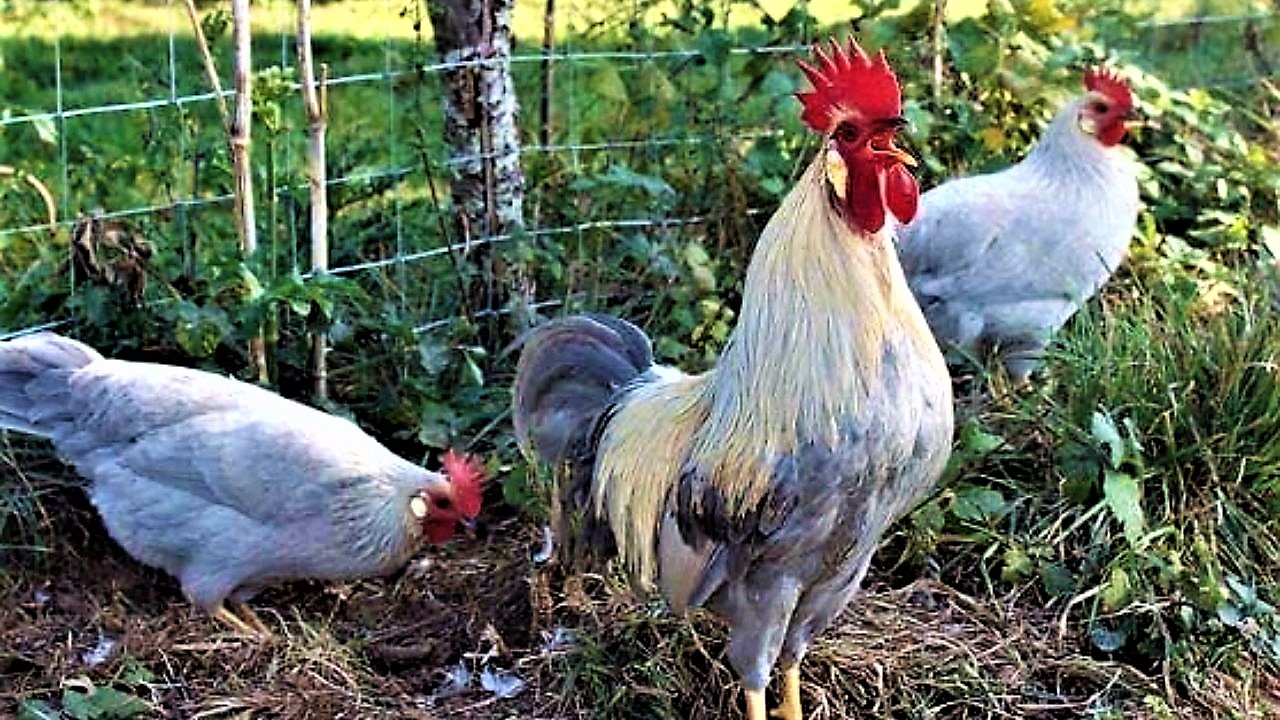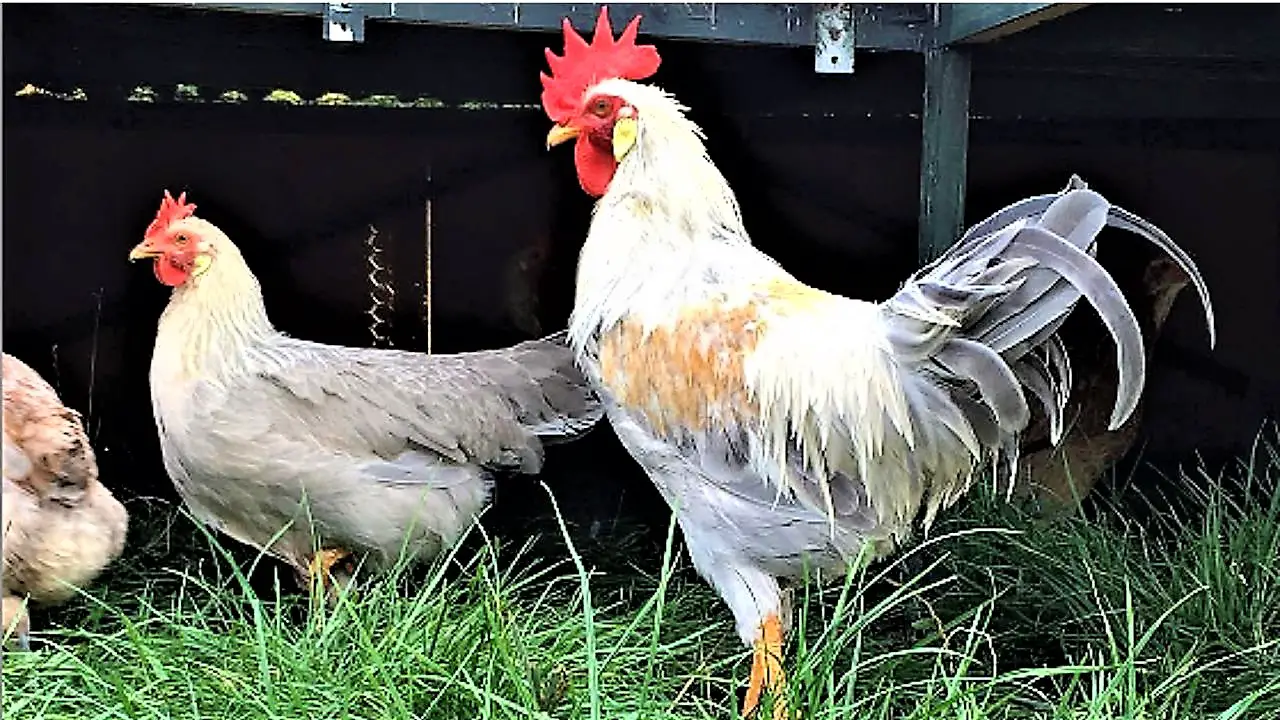Hey there! If you’ve been hearing whispers about Isabella Leghorn chickens, you’re in for a treat. I’m obsessed with these birds, and I can’t wait to share why they’re stealing the spotlight.
I first stumbled across photos of them online, and despite my coop being pretty much full, I had to add them to my flock. Trust me, these chickens aren’t just another breed – they’re fascinating, gorgeous, and downright remarkable.
Let’s dive into why everyone’s buzzing about them, from their stunning looks to their exceptional egg production.
What Makes Isabella Leghorns So Eye-Catching?
Oh, where do I start? Isabella Leghorns are stunning birds – total showstoppers! Hens rock pastel blue feathers with cream-colored accents, while roosters strut cream-colored feathers with blue striping.
Their feathers hit all the right spots – tail, breast, hackle, and saddle – in pastel creamy shades. Weighing in at 4-5 lbs, hens tip the scales at 4.5 pounds, pullets at 4 pounds, roosters at 6 pounds, and cockerels at 5 pounds.
They’ve got a rose comb, small, uniformly serrated, and perched on their head, adding attractive flair and tolerance to tricky temperatures.
Active and graceful, they’re superb foragers with a lively personality. Sure, they’re a bit flighty, but with some TLC, they turn calmer and friendlier.
What is an Isabella Leghorn
From the origin to now Isabella Leghorn chickens are recognized as egg machines, they are the most interesting breed of leghorns.
Isabella Leghorn originated in Italy, and the first Leghorn came to the United States in the 1800s and made himself famous for their uniqueness.
These chickens are also known as Isabella brown or Bovans Nera.
They are further refined and developed into breeds that we know today and they are recognized as the best eggs-laying breed.
Isabella Leghorn is a new variety of leghorns with pastel shades of cream and blue. They have a rose comb which improves tolerance to different temperatures. Isabella Leghorn is active and a little bit noisy and aggressive, they do well in free range and are also good foragers.
-
Isabella Leghorn Hens
Isabella Leghorn Hens are stunning and a machine for laying eggs. They are mostly bred for their high and efficient egg production abilities.
They produce around 250 to 300 white creamy-colored eggs per year. Isabella Leghorn Hens weigh around 4-5 lbs and have a pastel blue shade with cream-colored hackles and breasts.
-
Isabella Leghorn Roosters
Isabella Leghorn roosters are always the protector of the flock, roosters are more aggressive and noisy than hens. As Isabella Leghorn (male and female) is a more aggressive breed than normal, the roosters are more active and aggressive than other breeds of roosters.
Isabella Leghorn Roosters are quick to notice any unnecessary and threatening things. They have cream-colored hackle and saddle with blue striping on each feather while the tail and breast are an even shade of pastel blue.

Brief History of Isabella Leghorn
Italy, the early 1800s. That’s where the Leghorn breed kicked off, a famous chicken species with extraordinary egg-laying prowess. Brought to the U.S. around the 1820s, these birds quickly won over farmers and backyard chicken enthusiasts.
The Isabella Leghorn, a newer variety, popped up in the 1850s through selective breeding. This interesting variant blended a unique white and beige color, think brown or light brown combinations, with great egg-laying abilities.
Over time, breeders refined and improved them, creating the beautiful birds we love today. Their origin ties into a long history of skill in chicken breeding, making them a standout in the poultry world.
Eggs, Eggs, and More Eggs!
If you’re an egg lover, Isabella Leghorns are your perfect choice. These exceptional egg machines churn out 250-300 eggs annually – that’s 5-6 eggs weekly!
You’ll get large white eggs with a striking creamy white color, each weighing about 55 grams or more as the individual hen’s age climbs. Their egg size is big, thanks to good food and health, and they’re packed with high protein content.
Known as efficient layers, they’re a favorite option for backyard keepers and professional egg producers. Unlike breeds like Australorp or Easter Egger with colorful eggs, these white eggshells are a distinctive egg-laying feature.
For me, they’re the top egg-producing breed, consistently delivering a plentiful supply of high-quality eggs.
Physical Characteristics of Isabella Leghorns
Here are the physical characteristics of Isabella Leghorn:
-
Feathers
Isabella Leghorn has a mix of creamy white and soft beige-to-brown colours, like shades of cream and blue. Hens have a pastel blue shade with cream-colored hackles and breasts. Roosters have cream-colored hackles and saddles with blue striping on each feather, while the tail and breast are an even shade of pastel blue.
-
Weight
Isabella Leghorn is a medium-sized bird that weighs around 4-5 lbs. Its normal weight and medium size make it thrive in different activities.
-
Comb
The Isabella Leghorn has a remarkable rose comb that sits close to the head and has small, serrated teeth. The rose comb adds to its attractive look and helps it adapt well to various climates, making it a durable breed.
How to Care for Isabella Leghorn Chickens
Caring for Isabella Leghorns is a breeze if you know the basics. They thrive in free-range environments or big runs – think 10 square feet per bird outside.
Their foraging abilities shine when they’ve got room to roam. A bit flighty at first, they’ll settle into friendly birds with patience.
You can order them from Windy Whiskers Poultry, but you can also check hatcheries like Spikes Feed or online platforms.
Eggs or day-old chicks go for $6, $7, $10, or $12 per piece, depending on the breeder. No broody hen here, they’re all about egg purposes, not sitting. Their strong build and adaptability make them durable across climates.
Brown Leghornvs Isabella Leghorn
I’ve always loved raising chickens, and comparing Isabella Leghorns and Brown Leghorns is a treat because they’re America’s favorite breeds for a reason.
The Isabella Leghorns dazzle with their pretty white color, while Brown Leghorns rock a classic brown hue, both adding variety to any flock. Their color difference is striking, but they’re similar in how extremely active they are, always scratching around and being amazing foragers.
When it comes to egg size, both are extremely good egg layers. Isabella Leghorns lay large eggs – over 300+ eggs per year – and the pretty variety of white shells is a bonus.
Meanwhile, Brown Leghorns outdo them slightly with larger eggs, hitting 320+ eggs per year. Once you cracked a Brown Leghorn egg, it barely fit in your hand – talk about impressive!
Their personalities? Oh, they’re a hoot. Isabella Leghorns are the friendliest; they follow their owners like puppies. Brown Leghorns, though friendly, can get loud and a bit aggressive. It’s their temperament that keeps any yard lively, but the Isabella ones win my heart every time.
Both Leghorn breeds munch about 1.75 lbs per week of feed, making them super efficient at turning food into eggs. They forage so well that your feed bill stays low – pretty great, right?
The Isabella Leghorn is a new, rare variety, adding flair to the coop, while Brown Leghorns feel like trusty old friends. If you want good egg layers with big personalities, these chickens are the way to go!
Summary
So, why all the hype? Isabella Leghorns blend elegance and efficiency like no other. Their refined appearance, prolific egg production, and distinctive character make them elite breeds in the chicken industry.
From their Italy-to-U.S. journey to their pastel shades of cream and blue, they’re a perfect marriage of form and function. I think they’re a first choice for anyone who values beauty and productivity.
Ready to choose them? Trust me, you’ll notice the difference in your egg basket and your heart!
FAQs
Why are Leghorns not for beginners?
Leghorns can be tough for beginners because they’re super active, noisy, and don’t like being held. They’re independent and need more space, which might be hard if you’re new to raising chickens.
What is chicken Isabella?
Chicken Isabella, or Isabella Leghorn, is a special kind of Leghorn with pretty cream and blue feathers. It’s a newer type that’s great at laying eggs.
Is Leghorn a pure breed?
Yes, Leghorns are a pure breed! They started in Tuscany, Italy, and have been a recognized breed since the 1800s by the American Poultry Association.
Can Leghorns lay 2 eggs a day?
No, Leghorns usually lay just one egg a day. They’re awesome layers – up to 280-320 eggs a year – but two eggs in one day is super rare for any chicken.
Are Leghorns aggressive?
Leghorns aren’t usually aggressive, but they can be a little bossy. Roosters might act tougher, but most Leghorns aren’t mean.
Are Leghorns expensive?
Leghorns aren’t too pricey. They cost about the same as other chickens – around $15 for a baby chick, depending on where you buy them.
Do Leghorns grow fast?
Yes, Leghorns grow really fast! They’re ready to lay eggs by 18-20 weeks old, which is quick compared to many other chickens.
At what age do Leghorns start laying?
Leghorns start laying eggs at 18-20 weeks old. Some might even start at 16 weeks – pretty speedy!
What color eggs do Isabella Leghorns lay?
Isabella Leghorns lay white eggs. They’re big and bright, just like eggs from other Leghorns.
Is a broiler the same as a Leghorn?
Nope! Broilers are chickens raised for meat, while Leghorns are champs at laying eggs. They’re totally different!
Are Leghorns friendly?
Leghorns aren’t super friendly. They like doing their own thing and don’t love being picked up or cuddled.
What’s the weight of Isabella Leghorns?
Hens are 4.5 pounds, pullets 4 pounds, roosters 6 pounds, and cockerels 5 pounds – a moderate weight for medium-sized fowl.
Where can I buy them?
Try hatcheries like Windy Whiskers Poultry or Spikes Feed. Online platforms sell eggs, breeders, or sexed chicks.

Hello! I’m Ibrahim, the owner and writer of this blog. I run a chicken farm with 160 chickens, and I’ve gained a lot of knowledge about raising and caring for them. Now, I want to share my insights and experiences with you to help you in chicken keeping.


9 thoughts on “Why Everyone’s Talking About Isabella Leghorn Chickens”